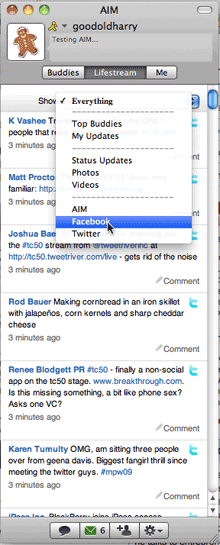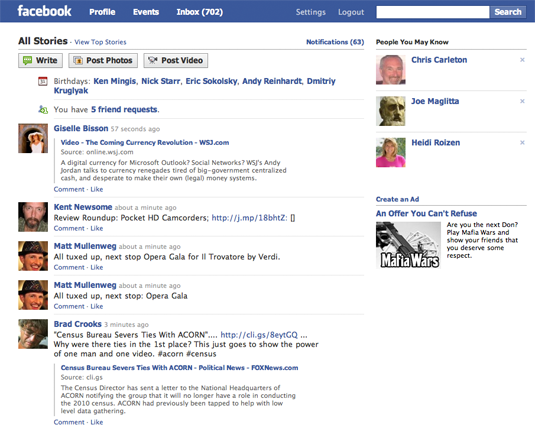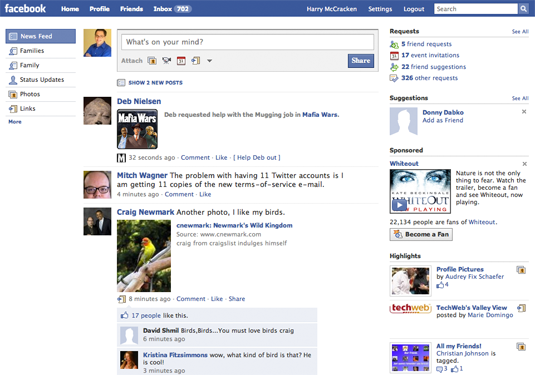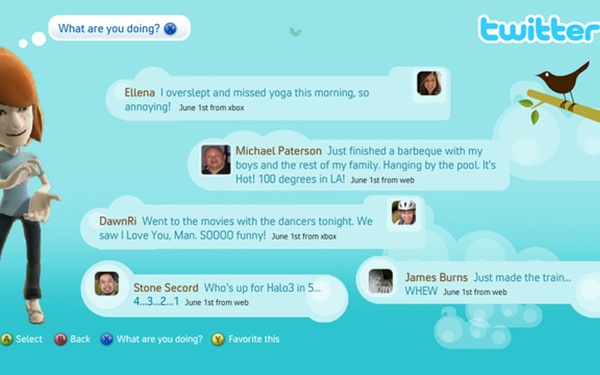 I’m still at TechCrunch50–it’s winding down, but there’s still so much going on that you’ll miss a product launch or two if you so much as take a restroom break. The debut that’s happening right now is one of the most interesting ones so far: Threadsy is a Web-based integrated communications service that looks uncommonly ambitious. It combines your e-mail (it supports Gmail, Yahoo Mail, etc), Twitter, Facebook, and other sources into two clusters of messages: “inbound” ones aimed directly at you (such as e-mail and Twitter @replies and Direct Messages) and “unbound” ones aimed at nobody in particular (such as Facebook status updates). And it tries to weave everything together so that items from a particular friend or acquaintance are tied together no matter which method of communications is involved. And it offers profiles, which seem to be super-address-book entries which are richest if the person in question belongs to Threadsy, but still there if they don’t.
I’m still at TechCrunch50–it’s winding down, but there’s still so much going on that you’ll miss a product launch or two if you so much as take a restroom break. The debut that’s happening right now is one of the most interesting ones so far: Threadsy is a Web-based integrated communications service that looks uncommonly ambitious. It combines your e-mail (it supports Gmail, Yahoo Mail, etc), Twitter, Facebook, and other sources into two clusters of messages: “inbound” ones aimed directly at you (such as e-mail and Twitter @replies and Direct Messages) and “unbound” ones aimed at nobody in particular (such as Facebook status updates). And it tries to weave everything together so that items from a particular friend or acquaintance are tied together no matter which method of communications is involved. And it offers profiles, which seem to be super-address-book entries which are richest if the person in question belongs to Threadsy, but still there if they don’t.
Like Gmail, Threadsy aims to make money by displaying context-sensitive ads based on keywords in your conversations. As I said in my post on the new social-network-aggregating version of AIM, I’m not sure if anyone has really figured out how to combine social networks and related streams in a way that’s simple, powerful, and as appealing as just going to all the information sources separately. But I can’t wait to give Threadsy a try. Apparently I won’t have to wait too long, and neither will anyone else: The service is still in private beta, but the company says that it’ll let in everyone who signs up for an invite over the next few days.

 I use AOL’s instant-messaging network all day long, but I’m not sure when I last used the AIM software itself (with the exception of the iPhone version). I’ve associated it with feature bloat, annoying ads, and a sort of old-timy, Web 1.0 feel. So I long ago switched to other clients that support the AIM network (Apple’s iChat when I’m on a Mac, GAIM when I’m on Windows, and the Web-based Meebo anywhere and everywhere).
I use AOL’s instant-messaging network all day long, but I’m not sure when I last used the AIM software itself (with the exception of the iPhone version). I’ve associated it with feature bloat, annoying ads, and a sort of old-timy, Web 1.0 feel. So I long ago switched to other clients that support the AIM network (Apple’s iChat when I’m on a Mac, GAIM when I’m on Windows, and the Web-based Meebo anywhere and everywhere). I’m trying the Mac beta, and it’s a Mac AIM client I’d actually use (hey, I’m chatting in another window even as we speak). It seems to lack some of the irritations that drove me away long ago, like ads popping up without warning. As for the social networking features, AOL has added support for Delicious, Digg, Facebook, Fickr, Twitter, and YouTube. It combines them all in a tab called Lifestream, lets you view all of them in one river of updates, or one service at a time, and permits you to broadcast your AIM status to other services whenever you update it. It also displays photos and videos from your pals directly in the AIM window.
I’m trying the Mac beta, and it’s a Mac AIM client I’d actually use (hey, I’m chatting in another window even as we speak). It seems to lack some of the irritations that drove me away long ago, like ads popping up without warning. As for the social networking features, AOL has added support for Delicious, Digg, Facebook, Fickr, Twitter, and YouTube. It combines them all in a tab called Lifestream, lets you view all of them in one river of updates, or one service at a time, and permits you to broadcast your AIM status to other services whenever you update it. It also displays photos and videos from your pals directly in the AIM window. I think of them as Facebook brain freezes: Every so often, when I’m on the site, I just get overwhelmed by the quantity of features it offers and can’t figure out how to do something simple such as post a photo. They’re a temporary condition, but a frustrating one. Which is why I’m intrigued by
I think of them as Facebook brain freezes: Every so often, when I’m on the site, I just get overwhelmed by the quantity of features it offers and can’t figure out how to do something simple such as post a photo. They’re a temporary condition, but a frustrating one. Which is why I’m intrigued by 

 One of the nice things about Facebook and Twitter is that they’re free to use, but won’t really be the case on the Xbox 360.
One of the nice things about Facebook and Twitter is that they’re free to use, but won’t really be the case on the Xbox 360.
